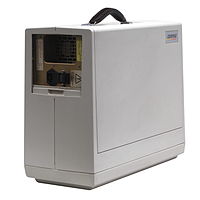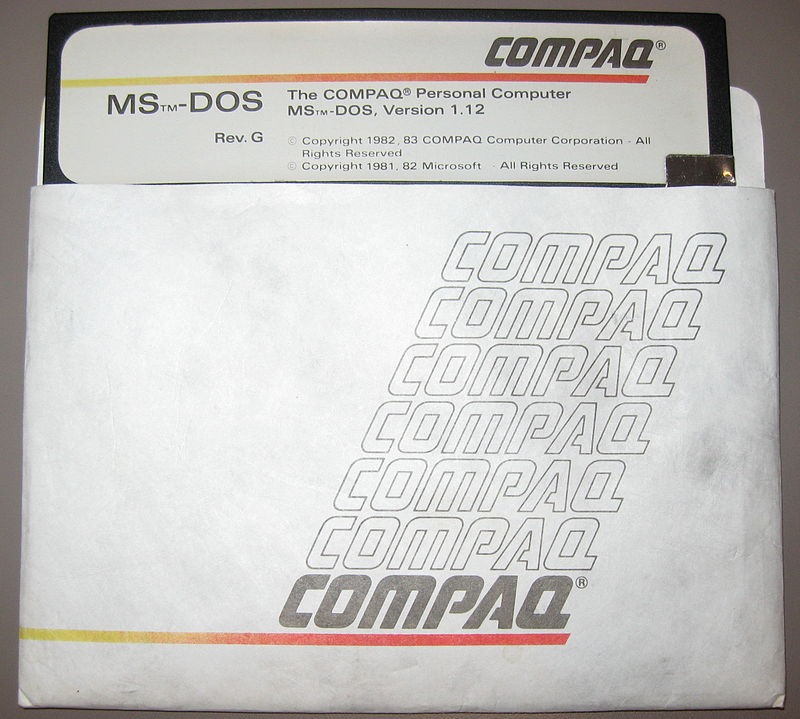Compaq Portable
Introduction
 First announced in November 1982 and released 4 months later, Compaq released their very first PC clone - the Portable. Unlike other fledgling PC compatible makers, Compaq chose to compete with features instead of price, and the Portable was an example of just that with its key feature being able to run all IBM PC software in a 'luggable' computer.
First announced in November 1982 and released 4 months later, Compaq released their very first PC clone - the Portable. Unlike other fledgling PC compatible makers, Compaq chose to compete with features instead of price, and the Portable was an example of just that with its key feature being able to run all IBM PC software in a 'luggable' computer.
It was the second PC-compatible ever, and the first that was legally an IBM PC clone due to Compaq's clever reverse-engineering of the IBM BIOS, rather than being a 'copy'. The Portable being their first computer, Compaq was eager to stress in their marketing campaigns the system's 100% PC compatibility.
Compaq computers were sold through a network of resellers rather than direct, with the company giving a lot of freedom for resellers to choose their prices and software merchandising. Through this network the Portable sold incredibly well with 53,000 units sold in its first year.
Fitted as standard with 128 KB of RAM and one or two double-sided floppy disk drives offering 360 KB capacity on each disk. Graphics capability from the 9" green-screen monitor was a combination of MDA and CGA. When the built-in monitor was active, it would display the MDA 9x14 font, but switching to an external monitor by pressing Ctrl-Alt-> would switch the text mode to the 8x8 font. This same graphics hardware was re-used on the first Compaq DeskPro desktop PC.

At launch, the Portable's operating system was Compaq DOS 1.12. This was basically MS-DOS but with a standalone BASIC interpreter that did not require the IBM Cassette BASIC in ROM. Within a few months however, Compaq began shipping Compaq DOS 2.00 which added hard disk support and a few other features.
A year later in October 1983, Compaq released a hard disk version of the Portable, called the Compaq Plus. This had a 10 MB hard disk built-in, furthering the utility value of their luggable computers. Aside from this update and a revised upgraded operating system, the Portable Plus was almost identical to its forebear.
A big change came about in 1986 with the launch of the Portable II. This was a lot sleeker and lighter than the initial Portable range, with the lightest "Model 1" weighing in at 23.6 lbs. It came as standard with an Intel 80286 microprocessor which clocked at 6 or 8 MHz (the latter when "Turbo" mode was enabled by pressing Ctrl-Alt-#). The Portable II could be upgraded with a variety of expansion cards, including 512 KB and 2048 KB memory cards that fitted into any of the 4 ISA slots, and 512 KB and 1536 KB memory boards that directly connected to the motherboard. This allowed a maximum capacity of 4.2 MB of RAM.
Versions Available
Compaq Portable with 2 DS/DD floppy drives: $3,590 MSRP.
Compaq Portable II Model 1 (single 5.25" floppy drive, 256 KB RAM): $3,499 MSRP.
Compaq Portable II Model 2 (dual 5.25" floppy drive, 256 KB RAM): $3,599 MSRP.
Compaq Portable II Model 3 (single 5.25" floppy drive, 10 MB hard disk, 640 KB RAM): $4,799 MSRP.
Compaq Portable II Model 4 (single 5.25" floppy drive, 20 MB hard disk, 640 KB RAM): $4,999 MSRP.
Supplied Software
Just as with the original IBM PC, no software was supplied bundled with the Portable aside from the operating system. Actually the Portable II didn't even come with that - you had to buy MS-DOS 3.1 separately! This was a fundamental decision made by Compaq to avoid the appearance of "bundling" as a marketing strategy. They felt the hardware should stand up by itself without gimmicky application software being thrown in for free.
Expansion / Compatibility
The Portable and Plus came with built-in serial and parallel ports for communication with modems, printers and other peripherals. It also had 5 expansion slots, despite being a portable computer - two of these slots are pre-populated though - one for the CGA display card and a second for the floppy disk controller.
The Portable II had 4 ISA expansion slots: 2 were 8-bit and 2 were 16-bit. The first 16-bit slot was always occupied out of the factory with a CGA graphics card, and one of the 8-bit slots was used up by an ATA drive controller card.
BIOS / RTC
The Portable's BIOS, similar to the 16K-64K models of the original IBM PC, was limited to 544 KB of RAM and did not support expansion ROMs (ROM extensions), thus making them unable to use EGA/VGA cards, hard disks, or similar hardware. After DOS 2.00 and the arrival of IBM's PC/XT, Compaq upgraded the BIOS to support ROM extensions.
The BIOS, being written from scratch, differs from the IBM PC and XT in some ways, while maintaining a very high degree of compatibility. It has a ROM BIOS signature of "COMPAQ".
With the Portable II, the BIOS is held in two 16 KB chips, so 32 KB total. BIOS Revision P supports 1.44 MB floppy drives.
Monitors / Graphics
Fitted with a 9" monochrome green-screen CRT monitor, the Portable and Portable Plus supported CGA and emulated MDA using CGA mode 3 (CGA text mode). It achieved this by changing the scan frequencies of the built-in monitor, so it's able to display all modes - you could argue this was the first "multi-scan" monitor, certainly fitted inside a portable computer!
The unit also had CGA and composite video out sockets. An external monitor could be connected and the display could be switched between the 9" built-in screen and the external monitor by holding down Ctrl and Alt and hitting the > or < key. When this occurred, the computer would automatically switch to a different font, for better text display on the respective screen.
In all, these are the display modes the Portable and Portable Plus are capable of:
MDA 80 x 25 text mode (9x14 character bitmaps)
CGA 80 x 25 text mode
CGA 40 x 25 text mode (8x8 character bitmaps)
CGA 640 x 200 graphics mode
CGA 320 x 200 graphics mode.
If the video card is in "high resolution" mode, no signal is sent to the external monitor socket. This is to protect the external monitor from incompatible MDA signals. The same display card from a Compaq DeskPro (original) can be used in the Portable or Portable Plus with a couple of jumper changes. These jumpers are responsible for the aforementioned disabling of external monitor port in MDA mode.
On the Portable II, you can switch between MDA and CGA modes by pressing Ctrl-Alt-Minus.
Keyboard / Mouse
The Portable II's keyboard uses standard PS/2 signalling, even though it's hard-wired into the system unit.
Floppy Disk Drives
Two types of floppy drive were used on the Compaq Portable II - one had a flip-up handle, and the other had a push button to eject the disk. The drive enclosure caters for two floppy drives, one on top of the other. Typically drive B: is in the upper bay and drive A: in the lower bay.
Hard Disks
The original Portable didn't come with a hard disk at all. The Portable Plus shipped with a 10 MB MFM hard disk built-in. These were manufactured by Rhodime and were apparently 'ruggedised' to support up to 40G of shock! You could distinguish a Plus from a non-Plus because the Plus had gold logo plates instead of silver. These days this is the only way of determining if the computer was originally a Portable or Portable Plus, as many Portables were upgraded with hard disks as they became more affordable.
Memory
CPU
Operating System
 The Portable shipped with a customised version of MS-DOS 1.12 on 5.25" floppy disk. This was superceded within a few months with MS-DOS 2.00, again customised by Compaq with additional utilities and branding.
The Portable shipped with a customised version of MS-DOS 1.12 on 5.25" floppy disk. This was superceded within a few months with MS-DOS 2.00, again customised by Compaq with additional utilities and branding.
FAQ
Q) How do I configure the DIP switches on my Portable/Plus?
A) The DIP switches on the Portable and DeskPro are very similar. Sometimes the DeskPro had a sticker on it showing how to set it up.
| Switch | Portable | Deskpro (PDF) | Deskpro (sticker) |
| 1 | Reserved (always off) | Reserved (always off) | Off: Normal |
| On: Enhanced | |||
| 2 | Numeric coprocessor | ||
| Off: 8087 installed | Off: 8087 installed | Off: 8087 installed | |
| On: No 8087 | On: No 8087 | On: No 8087 | |
| 3,4 | Memory size | ||
| Reserved (always off) | Both on: 640k | Both on: 640k | |
| 4 on, 3 off: 512k | 4 on, 3 off: 512k | ||
| 4 off, 3 on: 128k | 4 off, 3 on: 128k | ||
| Both off: 256k | Both off: 256k | ||
| 5,6 | Initial video mode | ||
| Both on: EGA | Both on: EGA | 5 on: CGA 24x80 | |
| 6 on, 5 off: CGA 40 | 6 on, 5 off: CGA 40 | 5 off: MDA 24x80 | |
| 6 off, 5 on: CGA 80 | 6 off, 5 on: CGA 80 | 6 on: IBM monitor | |
| Both off: MDA | Both off: MDA | 6 off: Compaq monitor | |
| 7,8 | Floppy drive count |
||
| Both on: 1 | Both on: 1 | 7 on: 1 | |
| 8 on, 7 off: 2 | 8 on, 7 off: 2 | 7 off: 2 | |
| 8 off, 7 on: 3 | 8 off, 7 on: 3 | 8 is "always on" | |
| Both off: 4 | Both off: 4 |
Physical Attributes
| Item | Dimensions (mm) | Weight (kg) |
|---|